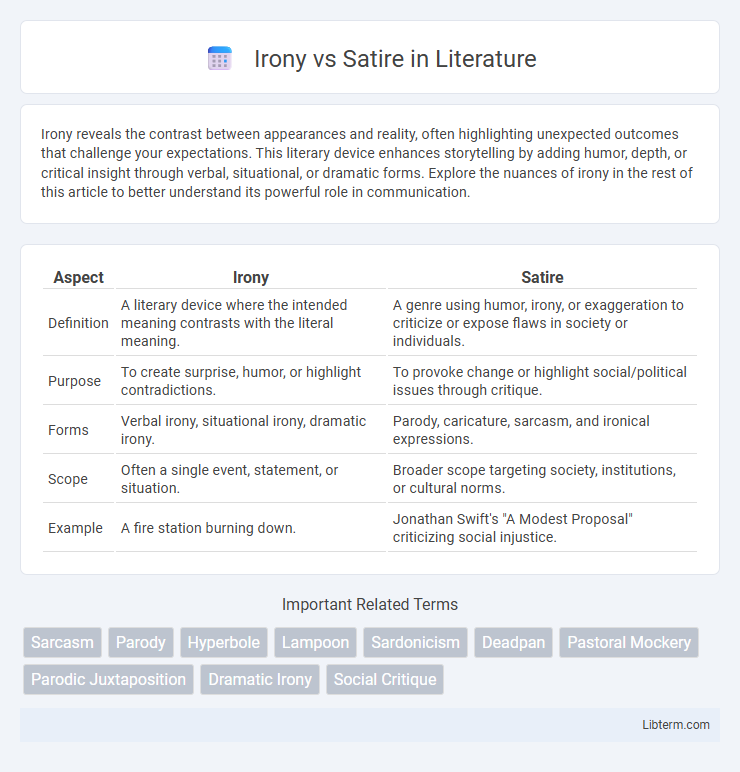Irony reveals the contrast between appearances and reality, often highlighting unexpected outcomes that challenge your expectations. This literary device enhances storytelling by adding humor, depth, or critical insight through verbal, situational, or dramatic forms. Explore the nuances of irony in the rest of this article to better understand its powerful role in communication.
Table of Comparison
| Aspect | Irony | Satire |
|---|---|---|
| Definition | A literary device where the intended meaning contrasts with the literal meaning. | A genre using humor, irony, or exaggeration to criticize or expose flaws in society or individuals. |
| Purpose | To create surprise, humor, or highlight contradictions. | To provoke change or highlight social/political issues through critique. |
| Forms | Verbal irony, situational irony, dramatic irony. | Parody, caricature, sarcasm, and ironical expressions. |
| Scope | Often a single event, statement, or situation. | Broader scope targeting society, institutions, or cultural norms. |
| Example | A fire station burning down. | Jonathan Swift's "A Modest Proposal" criticizing social injustice. |
Defining Irony: Meaning and Types
Irony is a literary device in which the intended meaning contrasts sharply with the literal meaning, creating a form of expressive contradiction. Types of irony include verbal irony, where words convey the opposite of their usual meaning; situational irony, where events unfold contrary to expectations; and dramatic irony, occurring when the audience knows critical information that characters do not. This nuanced use of contrast enhances storytelling by highlighting discrepancies between appearance and reality.
Understanding Satire: Purpose and Techniques
Satire employs irony, exaggeration, and humor to criticize or expose societal flaws, aiming to provoke thought and encourage change. Its techniques include parody, caricature, and juxtaposition, which highlight contradictions and absurdities in politics, culture, or human behavior. Unlike simple irony, satire combines wit with moral purpose to influence public opinion and inspire reform.
Key Differences Between Irony and Satire
Irony involves expressing meaning through language that normally signifies the opposite, often for humorous or emphatic effect, while satire uses irony, humor, and exaggeration to criticize or expose human vices and societal flaws. Irony is primarily a rhetorical device found in speech or text, whereas satire functions as a broader literary genre or form with a social or political purpose. Key differences include irony's focus on incongruity between appearance and reality, and satire's intent to provoke change or reflection through pointed critique.
Historical Origins of Irony and Satire
Irony traces its origins to ancient Greek literature, particularly in the plays of Sophocles and Euripides, where it was used to reveal the contrast between appearance and reality. Satire emerged in Roman times with authors like Horace and Juvenal, who employed humor, exaggeration, and ridicule to criticize social, political, and moral issues. Both literary devices evolved through the Renaissance and Enlightenment periods, solidifying their roles in shaping critical discourse and cultural commentary.
Irony in Literature and Media
Irony in literature and media involves a contrast between expectations and reality, often highlighting deeper truths through subtle or overt contradictions. Verbal irony occurs when characters say the opposite of what they mean, while situational irony presents outcomes that defy logical predictions, enhancing narrative complexity and emotional impact. Dramatic irony engages audiences by revealing information unknown to characters, creating suspense and critical reflection on human behavior.
Satire’s Role in Social Commentary
Satire serves as a powerful tool in social commentary by using humor, irony, and exaggeration to critique societal flaws, political corruption, and cultural norms. Through sharp wit and clever narrative, satire exposes hypocrisy and encourages critical thinking, prompting audiences to reflect on and challenge injustices. Prominent examples like Jonathan Swift's "A Modest Proposal" and modern shows such as "The Daily Show" highlight satire's enduring impact on public discourse and reform.
Common Examples of Irony and Satire
Irony often appears in literature and everyday speech through situations where the expected outcome contrasts sharply with reality, such as verbal irony in sarcastic remarks or situational irony in unexpected plot twists. Satire employs irony as a tool but extends further by using humor, exaggeration, and ridicule to critique societal flaws, exemplified by works like Jonathan Swift's "A Modest Proposal" or TV shows like "The Daily Show." Both devices rely on highlighting contradictions, though satire actively aims to provoke change or reflection on cultural and political issues.
How to Identify Irony vs Satire
Irony involves a contrast between expectation and reality, often highlighting a situation where the outcome is opposite to what is anticipated, making it identifiable through this paradox. Satire uses irony, exaggeration, and humor to criticize or mock societal flaws, requiring recognition of its underlying social or political commentary. To distinguish them, observe if the content merely presents unexpected contradictions (irony) or if it aims to provoke change or awareness by ridiculing targets (satire).
The Impact of Irony and Satire on Audiences
Irony and satire uniquely engage audiences by provoking critical thinking and emotional responses through humor and contradiction. Irony creates a gap between expectation and reality, encouraging the audience to perceive deeper meanings and question assumptions. Satire amplifies this effect by using exaggeration and ridicule to expose societal flaws, fostering awareness and inspiring change.
Mastering the Use of Irony and Satire in Writing
Mastering the use of irony and satire in writing involves understanding their distinct purposes: irony highlights contrasts between expectations and reality, while satire critiques societal flaws through humor and exaggeration. Effective writers employ verbal, situational, and dramatic irony to create layers of meaning, enhancing reader engagement and provoking thought. Crafting sharp satire requires a keen awareness of social context and the ability to blend wit with insight, making complex critiques accessible and impactful.
Irony Infographic

 libterm.com
libterm.com